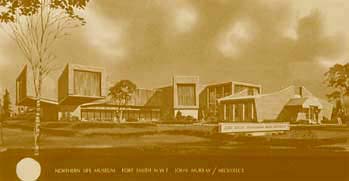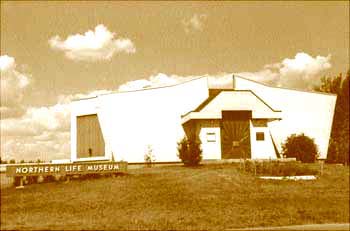The Home of the Muse: Oblates and the Northern Life Museum
-
The Home of the Muse: Oblates and the Northern Life Museum
Benjamin Lyle Berger
Research Associate, Provincial Museum of Alberta
Page 2
These principles carried over to the new building completed in 1973 by the municipality of Ft. Smith and filled with the items and stories collected by Oblates Br. Sareault and Fr. Ebner. The collection continued to grow and to attract visitors to the unique setting of the Northern Life Museum run by Br. Sareault and Fr. Ebner. Throughout this time in the history of the North, important artifacts were leaving by way of visitors, but the collecting efforts of Br. Sareault preserved an important cross-section of these items. Fr. Ebner told me that when people donated an item, "they gave it because they wanted to give it. Brother Sareault didn't give them a pep talk and try to wheel them out of it or anything."8 The collection and exhibits grew to represent the lives and stories of the Northern Canadian peoples. Though religious men, Fr. Ebner and Br. Sareault did not create a church museum per se. The museum had only one case dedicated to the church. I asked Fr. Ebner about this curious fact and he replied simply that the Oblates were "in everything."9 The lives of the Oblate Missionaries were so contiguous with those of the native people of the North that, from Br. Sareault and Fr. Ebner's position, a holistic picture of the culture of the North necessarily included the Oblates. The experience of the Oblates was suffused into the life of the North and the North was suffused into the experiences of the Oblates.

The above image is a sketch of the original plan for the Northern Life Museum. Below is the Northern Life Museum as it was built. Photos courtesy Father Francis Ebner.

The goal was to create an environment in which people might come to appreciate the culture of the North as reflected in text and exhibitions that sought to give the public a glimpse of a lifestyle that was rapidly changing. This was an ambitious task but was largely successful. Visitors remarked that Sareault and Ebner "show the true heart of a culture,"10 and that "only a kindred soul would know this value."11 The collection was "a solid contribution to our colorful culture"12 and was "very uplifting."13 The distinction of this accomplishment is underscored by the following analysis made by a scholar of museum studies, Constance Perin:
The relationship between exhibitions and what audiences carry away is not linear, but rather is complexly mediated by myriad factors, not the least of which are audiences' repertories of prior knowledge, semantic systems, and interpretive frames.14
Indeed, owing to their vast experience as members of communities in the North, Ebner and Sareault had unique access to these interpretive stances. Much of their success in the museum setting is, I believe, attributable to this unique existential understanding.
Fr. Ebner reflects that "after Br. Sareault passed away, I lost my brains."15 One of the minds that preserved the stories of the people of the Northwest Territories, accumulated over years of service to these communities, was now lost. Ebner, despite his own substantial knowledge of the north, deeply felt the loss of Brother Sareault - the loss of his knowledge, relationships, and sensibilities. Fr. Ebner was still able to arrange displays, run the exhibits, and draw from his own experience, but the stories and history provided by Br. Sareault - the lifeblood of the museum - was now lost . A new director, Bill Robbins, was appointed for the museum. His vision of the institution was necessarily different from that of Fr. Ebner and Br. Sareault. The over 12,000 artifacts were merely items for display - to attract - because the existential intimacy nurtured through decades of being "in everything" faded in the light of a formal administration neither rooted in nor "of" the community. One year later, in 1985, Fr. Ebner left his position as curator of the Northern Life Museum having been assigned by the Oblates to serve another community. Thus, the Oblate era of the Northern Life Museum ended.
The collection remains an Oblate achievement and reflects in its breadth and diversity the influence of its original curators, Fr. Ebner and Br. Sareault. Nonetheless, the question remains in my mind "what does a museum have to do with the religious vocation?"
Museums, when conceived of as places of learning and the transmission of culture, offer visions of beauty, of wonder, and of tradition. The artifacts shown and the stories told throw ropes backward into history simultaneously binding the past to modern consciousness and providing a means to explore the struggles, joys, failures, and wisdom of our predecessors. Anchored to the past but with a vision of the future, the museum has the potential to seed the self in a meaningful context. These are also among the many functions of the Church. Dillon Ripley writes the following:
I would contend that museums are the greatest available laboratory for studying the problem of how to create interest, and that this problem is central to our quest for survival as people.16
Our survival as people implies not only a ministering to the basic natural needs of humans, but to the social and spiritual needs that define us as human beings.17 Aspiring to a state of full being is central to the religious quest. By inspiring interest in one's own life and heritage, Br. Sareault and Fr. Ebner's work at the Northern Life Museum provided a source of healing for the souls of their community. Herein lies the religious good of the museum.
Sections


This project has been supported in part by the Canada-Alberta Agreement on French-language Services; the opinions expressed do not necessarily reflect the views of the Governments of Canada or Alberta.




Copyright © 2009 Heritage Community Foundation and
Institut pour le Patrimoine, Campus Saint-Jean, University of Alberta
All Rights Reserved
